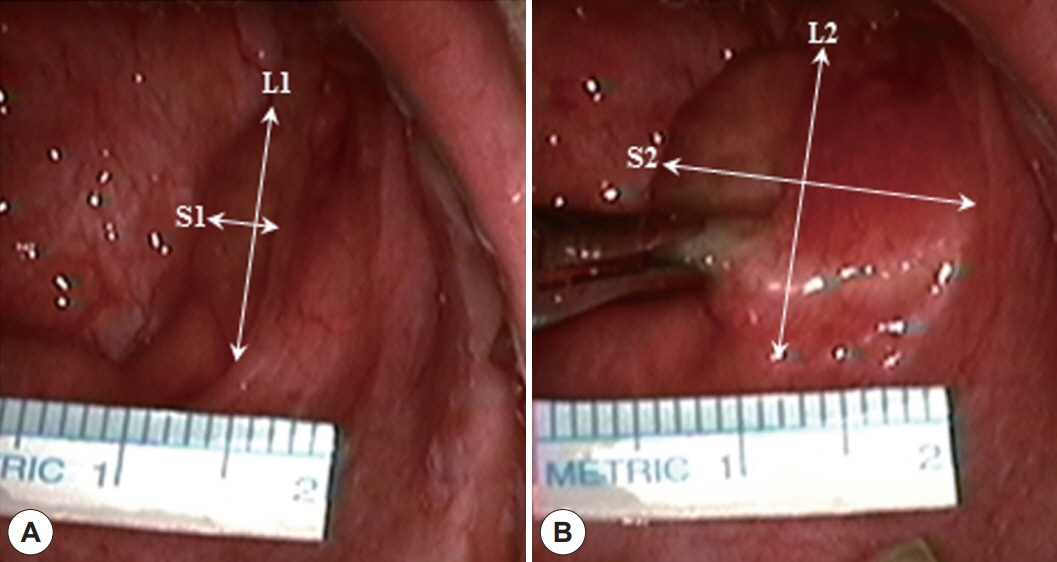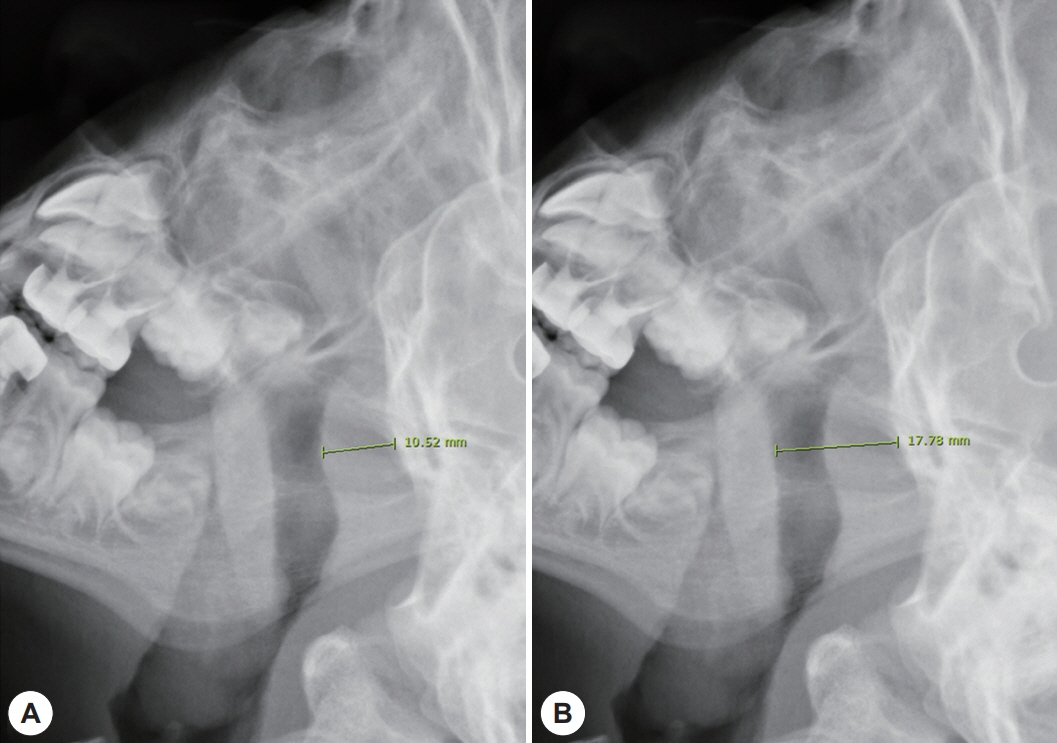J Rhinol.
2020 Nov;27(2):122-126. 10.18787/jr.2020.00335.
Assessment of Friedman Classification by Measuring Actual Tonsil Size During Surgery
- Affiliations
-
- 1Department of Otolaryngology-Head and Neck Surgery, Seoul St. Mary’s Hospital, College of Medicine, The Catholic University of Korea, Seoul, Korea
- KMID: 2508957
- DOI: http://doi.org/10.18787/jr.2020.00335
Abstract
- Background and Objectives
Adenotonsillar enlargement is a common cause of pediatric illnesses, including obstructive respiratory disease and recurrent airway infection. The current tonsil grading systems evaluate tonsil size, but the correlation with actual tonsillar size in a clinical setting has not been established. Materials and Method: Between May and July of 2018, we recruited 31 children who underwent adenotonsillectomy with no major craniofacial abnormalities. The actual size of the palatine tonsils, the long (L1) and short (S1) axes of the tonsil beyond the anterior pillar, and the real axes (L2 and S2) after tonsil extraction from the fossa were measured during surgery. Adenoid size was determined by measuring the adenoid-nasopharynx (AN) ratio through lateral view x-ray of the neck.
Results
Though S1 was related to the Friedman scale (p<0.001), measured real axes were not (L2: p=0.058, S2: p=0.056). Also, adenoid size and AN ratio did not relate statistically to the Friedman scale (p=0.565). One of the measured real tonsil size parameters (S2) was related to AN ratio (p=0.048).
Conclusion
For pediatric patients undergoing tonsillectomy and adenoidectomy, the Friedman grading scale based on physical examination may not reflect the actual size of the tonsils. Therefore, for children with obstructive sleep disorder or recurrent tonsillitis, intraoperative measurement of tonsil size can be helpful.
Keyword
Figure
Reference
-
References
1. Mitchell RB. Adenotonsillectomy for obstructive sleep apnea in children: outcome evaluated by pre- and postoperative polysomnography. Laryngoscope. 2007; 117(10):1844–54.2. Bellussi LM, Marchisio P, Materia E, Passali FM. Clinical guideline on adenotonsillectomy: the Italian experience. Adv Otorhinolaryngol. 2011; 72:142–5.3. Deutsch ES. Tonsillectomy and adenoidectomy. Changing indications. Pediatr Clin North Am. 1996; 43(6):1319–38.4. Friedman M, Tanyeri H, La Rosa M, Lansberg R, Vaidyanathan K, Pieri S, et al. Clinical predictors of obstructive sleep apnea. Laryngoscope. 1999; 109(12):1901–7.5. Dayyat E, Kheirandish-Gozal L, Sans Capdevila O, Maarafeya MM, Gonzal D. Obstructive sleep apnea in children: relative contributions of body mass index and adenotonsillar hypertrophy. Chest. 2009; 136(1):137–44.6. Brietzke SE, Gallagher D. The effectiveness of tonsillectomy and adenoidectomy in the treatment of pediatric obstructive sleep apnea/hypopnea syndrome: a meta-analysis. Otolaryngol Head Neck Surg. 2006; 134(6):979–84.7. Marcus CL, Brooks LJ, Ward SD, Draper KA, Gonzal D, Halbower AC, et al. Diagnosis and management of childhood obstructive sleep apnea syndrome. Pediatrics. 2012; 130(3):e714–55.8. Mitchell RB, Garetz S, Moore RH, Rosen CL, Marcus CL, Katz ES, et al. The use of clinical parameters to predict obstructive sleep apnea syndrome severity in children: the Childhood Adenotonsillectomy (CHAT) study randomized clinical trial. JAMA Otolaryngol Head Neck Surg. 2015; 141(2):130–6.9. Nolan J, Brietzke SE. Systematic review of pediatric tonsil size and polysomnogram-measured obstructive sleep apnea severity. Otolaryngol Head Neck Surg. 2011; 144(6):844–50.10. Brodsky L. Modern assessment of tonsils and adenoids. Pediatr Clin North Am. 1989; 36(6):1551–69.11. Kumar DS, Valenzuela D, Kozak FK, Ludemann JP, Moxam JP, Lea J, et al. The reliability of clinical tonsil size grading in children. JAMA Otolaryngol Head Neck Surg. 2014; 140(11):1034–7.12. Wang JH, Chung YS, Jang YJ, Lee BJ. Palatine tonsil size and its correlation with subjective tonsil size in patients with sleep-disordered breathing. Otolaryngol Head Neck Surg. 2009; 141(6):716–21.13. Yasan H, Aynali G, Erdogan O, Yariktas M. Does subjective tonsillar grading reflect the real volume of palatine tonsils? Int J Pediatr Otorhinolaryngol. 2011; 75(5):618–9.14. Baugh RF, Archer SM, Mitchell RB, Rosenfeld RM, Amin R, Burns JJ, et al. Clinical practice guideline: tonsillectomy in children. Otolaryngol Head Neck Surg. 2011; 144(1 Suppl):S1–30.15. Koltai PJ, Solares CA, Mascha EJ, Meng Xu MS. Intracapsular partial tonsillectomy for tonsillar hypertrophy in children. Laryngoscope. 2002; 112(8 Pt 2 Suppl 100):17–9.16. Tunkel DE, Hotchkiss KS, Carson KA, Sterni LM. Efficacy of powered intracapsular tonsillectomy and adenoidectomy. Laryngoscope. 2008; 118(7):1295–302.17. Bernstein JM, Reddy MS, Scannapieco FA, Faden HS, Ballow M. The microbial ecology and immunology of the adenoid: implications for otitis media. Ann N Y Acad Sci. 1997; 830:19–31.18. Lindroos R. Bacteriology of the tonsil core in recurrent tonsillitis and tonsillar hyperplasia--a short review. Acta Otolaryngol Suppl. 2000; 543:206–8.19. Nistico L, Kreft R, Gieseke A, Coticchia JM, Burrows A, Khampang P, et al. Adenoid reservoir for pathogenic biofilm bacteria. J Clin Microbiol. 2011; 49(4):1411–20.20. Sorin A, Bent JP, April MM, Ward RF. Complications of microdebrider-assisted powered intracapsular tonsillectomy and adenoidectomy. Laryngoscope. 2004; 114(2):297–300.
- Full Text Links
- Actions
-
Cited
- CITED
-
- Close
- Share
- Similar articles
-
- Relationship Between Adenotonsillar Size and Snoring Sound: Acoustic Analysis
- Analysis of the Treatment Outcomes of Obstructive Sleep Apnea Syndrome according to the Friedman Staging System
- The Effect of Tonsil Size on the Obstructive Sleep Apnea in Adults
- Incidence of Actinomycosis in the Tonsils and Its Clinical Significance
- Comparison of TLICS & McAfee Classification in Thoracolumbar Injuries



